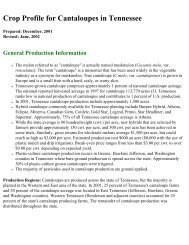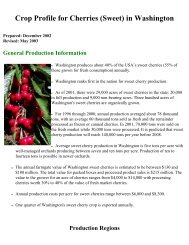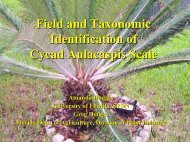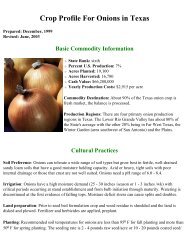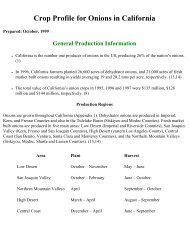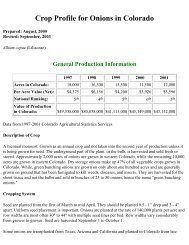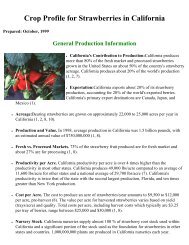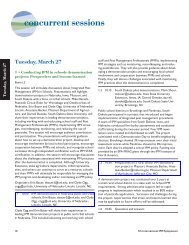Crop Profile for Onions in New York - Regional IPM Centers
Crop Profile for Onions in New York - Regional IPM Centers
Crop Profile for Onions in New York - Regional IPM Centers
Create successful ePaper yourself
Turn your PDF publications into a flip-book with our unique Google optimized e-Paper software.
% Acres Affected: up to 80% (estimated).<br />
Pest Life Cycles: The life cycle of this disease <strong>in</strong> onions <strong>in</strong> NY is be<strong>in</strong>g <strong>in</strong>vestigated. It appears that both young and old<br />
onion leaves can be <strong>in</strong>fected, but disease symptoms are most apparent on older leaves.<br />
Tim<strong>in</strong>g of Control: mid- to late season.<br />
Yield Losses: May be up to 40% <strong>in</strong> severely affected fields.<br />
Cultural and Post-Harvest Control Practices: Rout<strong>in</strong>e sanitary practices such as the destruction of cull piles and the<br />
removal of volunteer onions may help reduce possible sources of this disease. At present, the most important source of<br />
the pathogen appears to be its transmission on onion seed.<br />
<strong>Regional</strong> Differences: May be more of a problem <strong>in</strong> Orange County than other grow<strong>in</strong>g regions.<br />
Biological Control Practices: None.<br />
Chemical Controls: Several of the fungicides and fungicide comb<strong>in</strong>ations that control purple blotch and Botrytis leaf<br />
blight may control this disease. Mancozeb, iprodione, and chlorothalonil are recommended. See "Botrytis Leaf Blight"<br />
section <strong>for</strong> pesticide use patterns.<br />
Efficacy Issues: Research has shown that mancozeb used at the high rate <strong>in</strong> comb<strong>in</strong>ation with iprodione or<br />
chlorothalonil provides the best control.<br />
Downy Mildew (Peronospora destructor)<br />
Frequency of Occurrence: Sporadic but potentially serious.<br />
Damage Caused: Infection occurs on leaves > 10 <strong>in</strong>ches <strong>in</strong> length. Downy mildew may produce local lesions or it may<br />
be systemic. The older, outer leaves usually become <strong>in</strong>fected first. Local <strong>in</strong>fections appear as pale-green, oval to<br />
elongate slightly sunken lesions on leaves and seed stalks. In moist weather, these areas may be covered with a fuzzy,<br />
pale, purplish mold. Later the whole leaf may turn a dull pale green and then yellow. Systemically <strong>in</strong>fected plants are<br />
stunted and have distorted pale green leaves. Under moist conditions, a fuzzy violet fungal growth develops over the entire<br />
leaf surface. Bulbs produced by affected plants are often smaller than normal.<br />
% Acres Affected: up to 30%.<br />
Pest Life Cycles: Downy mildew is a potentially serious disease of onions particularly when onions are grown under<br />
cool, moist, and humid conditions. The fungus overw<strong>in</strong>ters as mycelium <strong>in</strong> <strong>in</strong>fected onion bulbs left <strong>in</strong> field after harvest<br />
and cull piles. It may also persist <strong>in</strong> the soil to <strong>in</strong>fect seedl<strong>in</strong>gs planted <strong>in</strong> the follow<strong>in</strong>g season. Spores produced dur<strong>in</strong>g<br />
the summer are carried by w<strong>in</strong>d to <strong>in</strong>fect new plants. Infection can spread very rapidly under cool, damp conditions.<br />
Tim<strong>in</strong>g of Control: July through end of season.<br />
Yield Losses: up to 50% <strong>in</strong> severely affected fields.<br />
Cultural and Post-harvest Control Practices: The follow<strong>in</strong>g practices help <strong>in</strong> disease management: removal and<br />
destruction of cull and volunteer onions; isolation of onions grown <strong>for</strong> seed; plant<strong>in</strong>g only mildew-free transplants; and<br />
rotation away from onions <strong>for</strong> two or more years.<br />
<strong>Regional</strong> Differences: This disease is more serious <strong>in</strong> cooler grow<strong>in</strong>g areas (e.g. Oswego and Steuben Counties), and is<br />
rarely seen <strong>in</strong> warmer grow<strong>in</strong>g areas (e.g. Orleans or Orange County).<br />
Biological Control Practices: None.<br />
Chemical Control Practices: Mefenoxam, maneb, and mancozeb are generally effective on downy mildew. See "Botrytis



